|
|
|
Sort Order |
|
|
|
Items / Page
|
|
|
|
|
|
|
| Srl | Item |
| 1 |
ID:
137365
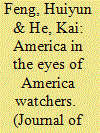

|
|
|
|
|
| Summary/Abstract |
Based on an original survey conducted in the summer of 2012 in Beijing, we examine how China's America watchers—IR scholars who work on US-China relations—have viewed China's power status in the international system, US-China relations and some specific US policies in Asia. Our survey shows that almost half of the survey participants thought that America would remain the global hegemon in the next ten years. Meanwhile, a large majority was also optimistic that China is a rising great power, especially in the economic sense, in the world. More than half of the respondents saw Asian military issues, such as the South China Sea issue, as the most difficult problem between China and the US.
|
|
|
|
|
|
|
|
|
|
|
|
|
|
|
|
| 2 |
ID:
128598
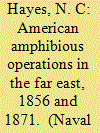

|
|
|
|
|
| Publication |
2013.
|
| Summary/Abstract |
The author examines two little known small scale amphibious operations from the mid 19th century, which still have some relevance to operations today.
|
|
|
|
|
|
|
|
|
|
|
|
|
|
|
|
| 3 |
ID:
130063
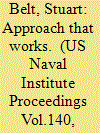

|
|
|
|
|
| Publication |
2014.
|
| Summary/Abstract |
When it comes to solving problems with China's overreach at sea, there are laws for that.
|
|
|
|
|
|
|
|
|
|
|
|
|
|
|
|
| 4 |
ID:
130610
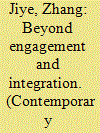

|
|
|
|
|
| Publication |
2014.
|
| Summary/Abstract |
As part of its new strategy of "retuming to the Asia-Pacific region", the A Obama administration has adopted some tough economic policies towards China, notably promoting the Trans-Paci?c Partnership (TPP) and attempting to establish new rules of international trade and investment aimed at strengthening economic ties with other Western countries through the Trans-Atlantic Trade and Investment Partnership Agreement(TTlP ), both of which tend to compress the geopolitical space for China's economic rise. The administration is also using a 'green barrier' to suppress the development of China's high-tech industry, and using economic diplomacy and investment restrictions against Chinese state-owned enterprises. This paper seeks to examine and analyze the causes of shifts in the U .S. economic strategy towards China.
|
|
|
|
|
|
|
|
|
|
|
|
|
|
|
|
| 5 |
ID:
133588
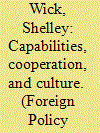

|
|
|
|
|
| Publication |
2014.
|
| Summary/Abstract |
The Sino-American relationship is arguably the most important bilateral relationship in the world. Whether this relationship remains peaceful or becomes conflictual will have far-reaching economic and political ramifications. For more than two decades, American analysts have been attempting to answer one question: Is China a threat to the United States? The result has been a voluminous collection of data that equally supports contradictory answers. I contend that if we want to understand the probable course of the Sino-American relationship, we need to ask a different question: When and why are Americans likely to perceive China as a threat? This paper reports the results of a social psychological experiment designed to explore the basis of American attitudes toward other states in general and toward China specifically. Contrary to expectations that economic insecurity drives American attitudes toward economic competitors, this study finds that American attitudes toward China are shaped primarily by cultural and institutional judgments. These results contribute to the field of IR by challenging preconceptions about the extent and potential impact of Americans' economic insecurities, by contributing to a nascent constructivist literature that examines how threat is constructed in the national imagination, and by informing how policymakers approach important bilateral relationships.
|
|
|
|
|
|
|
|
|
|
|
|
|
|
|
|
| 6 |
ID:
171102
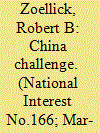

|
|
|
|
|
| Summary/Abstract |
One of the founding principles of constant confrontation is an assumption that cooperation with China failed. This is the premise that underpins the Trump administration's 2017 National Security Strategy. It's time to test that assumption.
|
|
|
|
|
|
|
|
|
|
|
|
|
|
|
|
| 7 |
ID:
112835
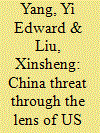

|
|
|
|
|
| Publication |
2012.
|
| Summary/Abstract |
China scholars have examined the 'China threat' theory from various theoretical perspectives, offered a range of explanations for the theory's emergence and forecast the potential implications for US-China relations. However, few scholars have empirically studied the 'China threat' theory through the lens of the US media. This is a critical oversight, because the media plays a pivotal role in shaping US public opinion and US foreign policy, and the media is a key channel for 'China threat' dissemination and popularization. This study seeks to redress this oversight by empirically examining 'China threat' coverage in the US print media over a 15-year period from 1992 to 2006. We use content-analysis methodology to systematically collect, code and analyze 'China threat' data from five major US newspapers and to track the frequency and content of this coverage over time.
Our analysis reveals many interesting patterns in 'China threat' media coverage. First, the initial emergence of 'China threat' arguments in the US print media corresponded with the sharp upward turn in China's economic growth rates in the early 1990s. However, since the early 1990s, 'China threat' coverage has not mirrored China's steady growth. Rather, the media coverage was cyclic, featuring three key peaks (1996, 2000 and 2005) followed by subsequent declining interest. Second, our analysis reveals that the focus of these stories also varied over time. Perceptions of China as a political/ideological threat dominated media coverage in the earlier years (1992-1994) but steadily declined after 1995 and totally disappeared from the US print media after 2001. Perceptions of China as a military/strategic threat replaced political/ideological concerns in 1995, and the military focus has dominated media coverage ever since. Perceptions of China as an economic/trade threat persisted steadily throughout the 15-year time period with a clear uptick in recent years. We conclude this analysis by turning to the literature on realism, agenda setting and information processing to offer possible explanations for these empirical trends.
|
|
|
|
|
|
|
|
|
|
|
|
|
|
|
|
| 8 |
ID:
128749
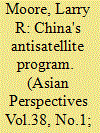

|
|
|
|
|
| Publication |
2014.
|
| Summary/Abstract |
I analyze the substance and goals of China's antisatellite program. Following China's 2007 antisatellite test that successfully destroyed one of its aging satellites, signs have emerged that China is continuing to research ways to exploit the heavy US reliance on space. This capability is most likely being developed as an "assassin's mace" to gain an advantage against a technologically superior enemy in the event of conflict. I propose a number of countermeasures to negate the threat to US space security
|
|
|
|
|
|
|
|
|
|
|
|
|
|
|
|
| 9 |
ID:
130416
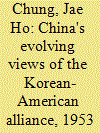

|
|
|
|
|
| Publication |
2014.
|
| Summary/Abstract |
This article reconstructs an ideational trajectory in which China's views of the Korean-American alliance evolved during the last 60 years. The article first surveys China's general policy toward alliance and alliance-making. The article then traces the evolutionary path of Chinese views in the following four periods: (1) the Cold War era (1950s-1960s); (2) transformative years (early 1970s-mid-1990s); (3) the period of a strained alliance (late 1990s-late 2000s); and (4) an era of great reversal (late 2000s-present). Principally, the article suggests that China's view of the Korean-American alliance was intense antagonism during the Cold War era, although it was significantly watered down during the transformative years of Sino-South Korean rapprochement. With the normalization of relations between Beijing and Seoul in 1992 and a decade of progressive rule (1998-2007) in South Korea, China's view encompassed some wishful thinking about a gradually diluted alliance. The strong comeback of the conservatives in South Korean politics since 2008, however, shattered such optimism and re-awoke Beijing to some cold realities. China's view of the Korea-American alliance may grow more negative in tandem with US-China relations, irrespective of the official rhetoric of sovereignty regarding alliance and alliance-making.
|
|
|
|
|
|
|
|
|
|
|
|
|
|
|
|
| 10 |
ID:
137441
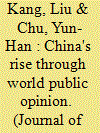

|
|
|
|
|
| Summary/Abstract |
Measuring the perception and attitudes of the world's public toward China has gained new momentum in recent years. In 2009, Shanghai Jiao Tong University's Institute of Arts and Humanities for the first time inaugurated a China-based National Image Survey Project, including a US survey (2010) and 12 Asian countries and regions (2011–2012). Authors in this special issue engage in interpretations and analysis of the data, and one of the most significant lessons is that public opinion, attitudes and perceptions of China's rise are the outcome of dynamic interactions and an assemblage of factors, a synergy of material interests, ideational and emotional reactions, and values, ideologies and principles, unraveling themselves against a highly volatile, precarious and contentious geopolitical backdrop, in which the interests of nation-states and individuals have become intertwined and inseparable.
|
|
|
|
|
|
|
|
|
|
|
|
|
|
|
|
| 11 |
ID:
101315
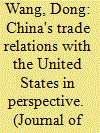

|
|
|
|
|
| Publication |
2010.
|
| Summary/Abstract |
China's trade relations with the United States over the past four decades is a topic that has not been fully dealt with in scholarly works. This paper charts the course of US-China economic relations since 1971, explains the principal forces stimulating growth and encouraging change and, finally, discusses how these two economic giants fit into an interlocking Asian and world economy. In reaction to the post-2008 financial downturn, advocates for a new world economic order have suggested a rebalancing of global demand, which will arguably become a major, politically charged issue in the US and in China in the years to come. Growing economic interdependence has quickly presented new challenges and opportunities, with issues such as human rights, Most-Favoured-Nation status, the Taiwan and Tibet question, and the huge American trade deficit threatening to cloud the relationship at times. With China's emergence as a major power and America's hegemonic ambitions tested in successive wars, the contradiction between a booming commercial relationship and conflict associated with geopolitical and ideological differences will continue to constitute a serious challenge. The long-term goal for each side will be to forge economic ties strong enough to create a stable political relationship, rather than to be held hostage by geopolitical constraints.
|
|
|
|
|
|
|
|
|
|
|
|
|
|
|
|
| 12 |
ID:
130609
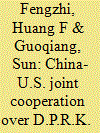

|
|
|
|
|
| Publication |
2014.
|
| Summary/Abstract |
In February 12, 2013, North Korea announced it had successfully Conducted its third underground nuclear test. After such a dangerous move, the U.S. and South Korea tightened their bilateral security cooperation and beefed up defense measures. This caused tensions to escalate on the Korean Peninsula, and the situation appeared to spin out of control. The crisis pushed China and the U.S. together to work on this issue. This article will analyze those deep-seated factors affecting bilateral cooperation and make an initial exploration 'of its prospects while providing an overview of their joint actions to solve the North Korean nuclear issue.
|
|
|
|
|
|
|
|
|
|
|
|
|
|
|
|
| 13 |
ID:
110689
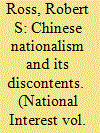

|
|
|
|
|
| Publication |
2011.
|
| Summary/Abstract |
AT NO time since the end of the Cold War have U.S.-China relations been worse. Yes, in the past there have been periodic confrontations over Taiwan, and tensions over the American bombing of the Chinese embassy in Belgrade and the Chinese fighter-jet collision with an American reconnaissance plane over the South China Sea. But the current downturn reflects a potential long-term trend with the likelihood of protracted strategic conflict. Equally troubling, this raising of tensions is not only unnecessary but also potentially costly to the United States.
|
|
|
|
|
|
|
|
|
|
|
|
|
|
|
|
| 14 |
ID:
130164
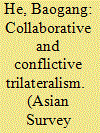

|
|
|
|
|
| Publication |
2014.
|
| Summary/Abstract |
This paper provides a critical overview of Australian, Chinese, and American perspectives on trilatesralim, with a detailed discussion of Australian debates on the matter. Its aim is to trace the evolution of the changing discourse on the rise of China, examine major debates in Australia, and provide both an intellectual background and an overview for this special issue.
|
|
|
|
|
|
|
|
|
|
|
|
|
|
|
|
| 15 |
ID:
186924
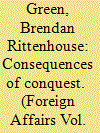

|
|
|
| 16 |
ID:
092263


|
|
|
|
|
| Publication |
2009.
|
| Summary/Abstract |
Chinese and Korean protests over "revisionist" Japanese histories of World War II are well known. The impact of contested Chinese and US histories of the Korean War on US-China relations today has received less attention. More broadly, there has been little research seeking to systematically explore just how history textbook controversies matter for international relations. This article experimentally manipulates the impact of nation (US/China), of source (in-group/out-group textbooks), and of valence (positive/negative historical narratives) on measures of beliefs about the past, emotions, collective self-esteem, and threat perception in present-day US-China relations. A 2 × 2 × 2 design exposed randomized groups of Chinese and US university students to fictional high school history textbook accounts of the Korean War. Findings reveal significant effects of nation, source, and valence and suggest that the "historical relevance" of a shared past to national identities in the present has a dramatic impact on how historical controversies affect threat perception.
|
|
|
|
|
|
|
|
|
|
|
|
|
|
|
|
| 17 |
ID:
132463


|
|
|
|
|
| Publication |
2014.
|
| Summary/Abstract |
China and the US both recognise that an armed conflict between them would include cyber warfare. But there is a curious and risky failure to connect the tactical military advantages of cyber attacks with the strategic hazards.
|
|
|
|
|
|
|
|
|
|
|
|
|
|
|
|
| 18 |
ID:
107160
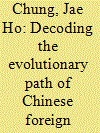

|
|
|
|
|
| Publication |
2011.
|
| Summary/Abstract |
Chinese foreign policy has made a grand transition during the post-Mao reform era. Chinese foreign policy of the 21st century has become much more open and pragmatic in its relations with the outside world, more extensive in its reach and coverage, highly diversified in its functions and partners, more committed to international norms than before, and much more sophisticated in its dealing with the international community. Yet, the precise balance between the changes and continuities is still quite difficult to gauge. Furthermore, despite crucial visible changes, concerns and worries - even some fears - are discernible with regard to the rise of China. In the last 60 years, Beijing has sought hard to sustain consistencies (shizhong ruyi) in its foreign policy. Perhaps, that is the best clue the world has in inferring the future trajectory of Chinese foreign policy.
|
|
|
|
|
|
|
|
|
|
|
|
|
|
|
|
| 19 |
ID:
107177
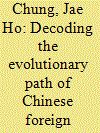

|
|
|
|
|
| Publication |
2011.
|
| Summary/Abstract |
Chinese foreign policy has made a grand transition during the post-Mao reform era. Chinese foreign policy of the 21st century has become much more open and pragmatic in its relations with the outside world, more extensive in its reach and coverage, highly diversified in its functions and partners, more committed to international norms than before, and much more sophisticated in its dealing with the international community. Yet, the precise balance between the changes and continuities is still quite difficult to gauge. Furthermore, despite crucial visible changes, concerns and worries - even some fears - are discernible with regard to the rise of China. In the last 60 years, Beijing has sought hard to sustain consistencies (shizhong ruyi) in its foreign policy. Perhaps, that is the best clue the world has in inferring the future trajectory of Chinese foreign policy.
|
|
|
|
|
|
|
|
|
|
|
|
|
|
|
|
| 20 |
ID:
116051
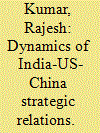

|
|
|
|
|
|
|
|